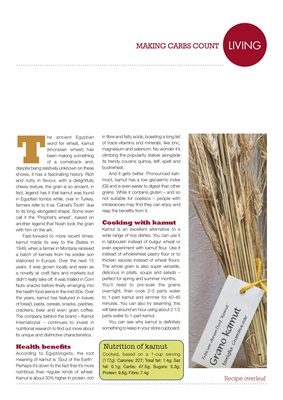
KITLIVING
Used The ancient Egyptian
word for wheat, kamut
(khorasan wheat) has
been making something
of a comeback and,
despite being relatively unknown on these
shores, it has a fascinating history. Rich
and nutty in flavour, with a delightfully
chewy texture, the grain is so ancient, in
fact, legend has it that kamut was found
in Egyptian tombs while, over in Turkey,
farmers refer to it as 'Camel's Tooth' due
to its long, elongated shape. Some even
call it the 'Prophet's wheat', based on
another legend that Noah took the grain
with him on the ark.
Fast-forward to more recent times,
kamut made its way to the States in
1949, when a farmer in Montana received
a batch of kernels from his soldier son
stationed in Europe. Over the next 15
years, it was grown locally and seen as
a novelty at craft fairs and markets but
didn't really take off. It was trialled in Corn
Nuts snacks before finally emerging into
the health food arena in the mid-80s. Over
the years, kamut has featured in loaves
of bread, pasta, cereals, snacks, pastries,
crackers, beer and even grain coffee.
The company behind the brand - kamut
International - continues to invest in
nutritional research to find out more about
its unique and distinctive characteristics.
Health benefits
According to Egyptologists, the root
meaning of kamut is 'Soul of the Earth'.
Perhaps it's down to the fact that it's more
nutritious than regular kinds of wheat.
Kamut is about 30% higher in protein, rich
Cooked, based on a 1-cup serving
(172g): Calories: 227; Total fat: 1.4g; Sat
fat: 0.1g; Carbs: 47.5g; Sugars: 5.3g;
Protein: 9.8g; Fibre: 7.4g
Nutrition of kamut
MAKING CARBS COUNT Recipe overleaf
in fibre and fatty acids, boasting a long list
of trace vitamins and minerals, like zinc,
magnesium and selenium. No wonder it's
climbing the popularity stakes alongside
its trendy cousins quinoa, teff, spelt and
buckwheat.
And it gets better. Pronounced kahmoot, kamut has
a low glycaemic index
(GI) and is even easier to digest than other
grains. While it contains gluten - and so
not suitable for coeliacs - people with
intolerances may find they can enjoy and
reap the benefits from it.
Cooking with kamut
Kamut is an excellent alternative to a
wide range of rice dishes. You can use it
in tabbouleh instead of bulgur wheat or
even experiment with kamut flour. Use it
instead of wholewheat pastry flour or to
thicken sauces instead of wheat flours.
The whole grain is also super versatile,
delicious in pilafs, soups and salads -
perfect for spring and summer months.
You'll need to pre-soak the grains
overnight, then cook 2-3 parts water
to 1-part kamut and simmer for 40-45
minutes. You can also try steaming: this
will take around an hour using about 2 1/2
parts water to 1-part kamut.
You can see why kamut is definitely
something to keep in your store cupboard.